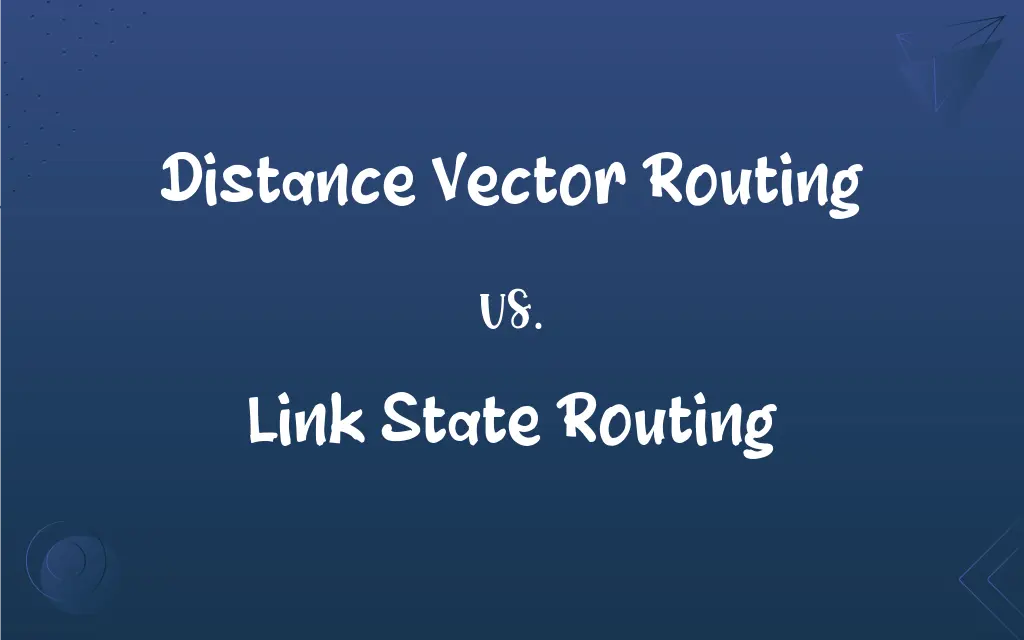Distance Vector Routing vs. Link State Routing: What's the Difference?
Edited by Aimie Carlson || By Janet White || Published on February 19, 2024
Distance vector routing determines paths based on distance metrics from each node, while link state routing uses global topology knowledge for path determination.

Key Differences
Distance vector routing is a protocol in which each router constructs a vector (table) of the distance to every possible destination in the network, typically measured in hops. The routers periodically share these vectors with their neighbors. In link state routing, each router maintains a comprehensive map of the network's topology, updating it with the state of each link (like bandwidth and up/down status), allowing for more informed and dynamic route decisions.
Distance vector routing operates on a simpler mechanism, where each router only knows the distance to its immediate neighbors and destinations. This simplicity can lead to slower convergence and issues like routing loops. Link state routing, however, involves more complex algorithms and requires routers to broadcast link state information to the entire network, leading to quicker convergence and a more stable network but at the cost of increased overhead.
In distance vector routing, updates are shared at regular intervals or when significant network changes occur, which can sometimes lead to slow reaction to network changes. Link state routing is more responsive to changes in the network, as routers immediately broadcast changes in link status, allowing the network to quickly adapt and re-route traffic.
Distance vector routing protocols, such as RIP (Routing Information Protocol), are often easier to implement and require less computational power and memory. In contrast, link state routing protocols like OSPF (Open Shortest Path First) and IS-IS require more memory and processing power due to the need to maintain and compute on the entire network's topology.
Scalability is a key difference between the two: distance vector routing is more suited for smaller networks due to its limited knowledge scope and slower convergence times. Link state routing scales better to larger networks, offering more efficient routing decisions and faster convergence but requiring more resources.
ADVERTISEMENT
Comparison Chart
Routing Knowledge
Limited to distance to neighbors and destinations
Comprehensive map of network's topology
Complexity and Overhead
Simpler, less overhead
More complex, higher overhead
Convergence Speed
Slower convergence, prone to loops
Faster convergence, more stable
Response to Network Changes
Slower response to changes
Quick adaptation to changes
Scalability
Better suited for smaller networks
Better for larger networks
ADVERTISEMENT
Example Protocols
RIP (Routing Information Protocol)
OSPF (Open Shortest Path First), IS-IS
Resource Requirements
Lower computational and memory requirements
Higher computational and memory needs
Routing Updates
Periodic or on significant changes
Immediate on link status changes
Distance Vector Routing and Link State Routing Definitions
Distance Vector Routing
Distance vector routing uses distance metrics to determine paths.
In our small network, we use distance vector routing for its simplicity.
Link State Routing
This routing type requires more memory and processing power.
Due to its complexity, our routers need more power for link state routing.
Distance Vector Routing
It's more prone to routing loops and slow convergence.
To prevent routing loops, we configured route poisoning in our distance vector protocol.
Link State Routing
It involves routers knowing the state of each network link.
Routers in link state routing broadcast changes in link status to the entire network.
Distance Vector Routing
This routing is simpler and less resource-intensive.
We chose distance vector routing for our resource-constrained network.
Link State Routing
Link state routing is based on Dijkstra's algorithm.
OSPF, a link state protocol, uses Dijkstra's algorithm for the shortest path routing.
Distance Vector Routing
It involves routers sharing vectors of distances to destinations.
Each router updates its neighbors with its distance vector table.
Link State Routing
It's suited for larger, more dynamic networks.
For our dynamically changing network, link state routing offers quick adaptation.
Distance Vector Routing
Distance vector routing is based on the Bellman-Ford algorithm.
RIP, a distance vector protocol, implements the Bellman-Ford algorithm.
Link State Routing
Link state routing uses a complete view of network topology for routing.
Our large network benefits from the link state routing's efficient path calculations.
FAQs
What is link state routing?
A routing method using complete network topology knowledge for routing.
What is distance vector routing?
A routing protocol using distance metrics for path determination.
Are distance vector protocols prone to routing loops?
Yes, they are more prone to loops and slow convergence.
What are examples of distance vector routing protocols?
Examples include RIP (Routing Information Protocol).
How do routers in distance vector routing share information?
They share vectors containing distances to each destination.
Can link state routing handle dynamic network changes efficiently?
Yes, it's well-suited for dynamic and rapidly changing networks.
What are examples of link state routing protocols?
OSPF (Open Shortest Path First) and IS-IS are examples.
Which routing protocol is better for large networks?
Link state routing is more suitable for large networks.
Which is simpler to implement, distance vector or link state routing?
Distance vector routing is simpler and less resource-intensive.
What algorithm does link state routing typically use?
It often uses Dijkstra's algorithm for shortest path calculations.
Is distance vector routing suitable for small networks?
Yes, it's better suited for smaller, less complex networks.
Do distance vector protocols use periodic updates?
Yes, they periodically update neighbors with distance information.
Can distance vector routing quickly adapt to network changes?
It is slower to adapt compared to link state routing.
How does link state routing handle network scalability?
It scales well to larger networks due to its comprehensive view.
Is link state routing compatible with dynamic environments?
Yes, it's ideal for environments with frequent network changes.
Is link state routing more responsive to network changes?
Yes, it quickly adapts to changes due to immediate broadcasting of link status.
Why is link state routing more resource-intensive?
Due to maintaining and computing a complete network map.
What is a disadvantage of distance vector routing?
Its slower convergence and vulnerability to routing loops.
Does distance vector routing require less memory?
Yes, it requires less computational power and memory.
How does link state routing handle link failures?
It quickly recalculates routes based on updated network topology.
About Author
Written by
Janet WhiteJanet White has been an esteemed writer and blogger for Difference Wiki. Holding a Master's degree in Science and Medical Journalism from the prestigious Boston University, she has consistently demonstrated her expertise and passion for her field. When she's not immersed in her work, Janet relishes her time exercising, delving into a good book, and cherishing moments with friends and family.
Edited by
Aimie CarlsonAimie Carlson, holding a master's degree in English literature, is a fervent English language enthusiast. She lends her writing talents to Difference Wiki, a prominent website that specializes in comparisons, offering readers insightful analyses that both captivate and inform.































































